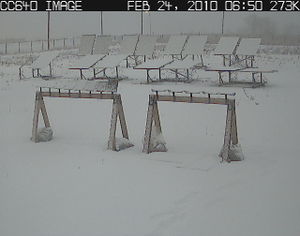Introduction
Photovoltaic solar cell systems represent one of the most promising means of maintaining our energy intensive standards of living.[1] With Canada, and Ontario in particular, concentrating a much larger focus on photovoltaic development, there is a keen interest and concern in the effects of snow cover on solar energy yield. From small scale residential to large multi-MW ventures, developers are interested in the effect of snow on the performance of different types of panels and on the optimization of racking angles. This research project, sponsored by Sustainable Energy Technologies, and in collaboration with Photovoltaic Performance Labs Inc. will assist this optimization.
The data collected from this project will lead the development of a model which will predict the annual losses due to snowfall for arrays set at a variety of angles. This information will allow developers to make more informed decisions when installing photovoltaic arrays in northern climates. The test apparatus consists of the following elements:
16 panel solar array
- There are 8 panels each of Nexpower amorphous silicon framed 100W and 8 panels of Bosch unframed micro-morph silicon 100W panels positioned at angles from 0 to 70 degrees from the horizontal in 10 degree increments.
- The panel at 0 degrees can pivot and allows for "dump" tests to determine the critical angle for snow shedding.
- The short circuit current of the panels is measured by a datalogger to give real time power outputs correlated directly with metrological and thermal measurements.
Meteorological sensors
- Snow sensor- Ultrasonic Snow sensor measures current snow depth. This is the same sensor used by Environment Canada for their snow depth measurements
- Ambient temperature- Radiation Shielded thermometer gives an accurate indication of the ambient temperature
- Wind speed and direction
- Incident solar radiation- Direct and diffuse solar radiation data will be used from a nearby solar laboratory
Thermal and panel power sensors
- 32 channels of T-type thermocouples measure the temperature at the top and bottom of each panel
- 16 channels of shunt wiring measures the voltage drop across a resistor in series with each PV short circuit loop. This gives an accurate measurement of short circuit current.
Visual observations
- A outdoor rated digital camera will be mounted nearby and used to take photographs of the array at constant intervals.
- This will allow for an analysis of the total snow cover, the snow melting patterns over time, as well as the collection of the snow shed beneath a panel.
Campbell scientific datalogger
- A stand-alone datalogger running on battery power with a cellular modem for external communications
- Monitors metrological conditions, panel power, and panel temperature through two multiplexers
Physical measurements
- Measurements will also be taken by hand at larger intervals on the following parameters
- Snow water equivalent- This is a measure of the relative density of the snow, and will be taken using snow cores.
- Accumulated precipitation- Measured using a standard rain gauge, will give another measure of the total precipitation between measurements
- Panel snow accumulation- Will measure the height of snow accumulation at the top and bottom of each panel.
Applications
The data collected from this apparatus will assist in determining the following parameters, which are essential to a proper PV system design
- effect of angle on snow related power losses
- effect of framing on snow related power losses
- "critical" angles for snow shedding as a function of temperature
- snow melt characteristics as a function of temperature and snow cover
Results

With the first year of testing completed, data analysis is currently under way to determine the effects of snowfall on the array of panels
Expansion
This study offers a very detailed dataset for determining snow related losses for the two panels being utilized. However an expansion of this study would allow for a broader accumulation of datasets, and would result in a much more robust model. If you are interested, please contact Joshua Pearce.
To work on
- Frame markings for measurement
- orientation and near shading check with suneye
- detailed protocols, equipment specifications
- data file description, data manipulation protocol
Related Pages
References
- ↑ J. M. Pearce, Photovoltaics - A Path to Sustainable Futures, Futures 34 (7), 663-674, 2002